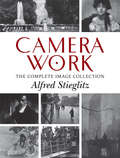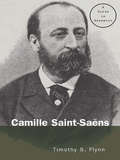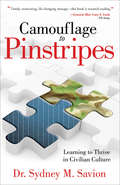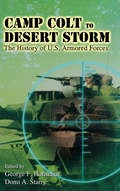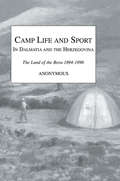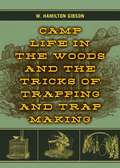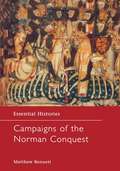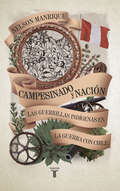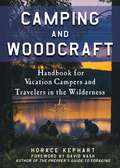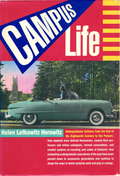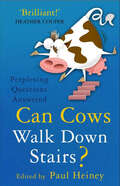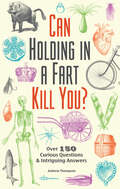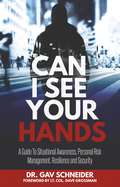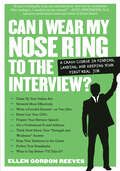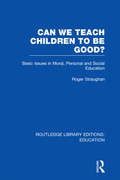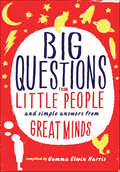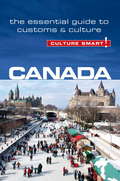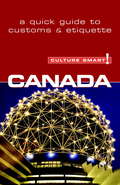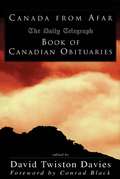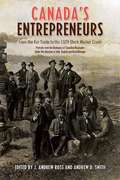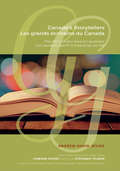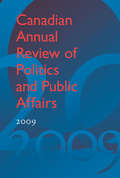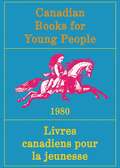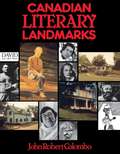- Table View
- List View
Cambridge Studies in Medieval Literature: The Medieval Manuscript Book
by Michael JohnstonTraditional scholarship on manuscripts has tended to focus on issues concerning their production and has shown comparatively little interest in the cultural contexts of the manuscript book. The Medieval Manuscript Book redresses this by focusing on aspects of the medieval book in its cultural situations. Written by experts in the study of the handmade book before print, this volume combines bibliographical expertise with broader insights into the theory and praxis of manuscript study in areas from bibliography to social context, linguistics to location, and archaeology to conservation. The focus of the contributions ranges widely, from authorship to miscellaneity, and from vernacularity to digital facsimiles of manuscripts. Taken as a whole, these essays make the case that to understand the manuscript book it must be analyzed in all its cultural complexity, from production to transmission to its continued adaptation.
Camera Work: The Complete Image Collection
by Alfred StieglitzMany of the early twentieth century's finest examples of photography and modernist art reached their widest audience in the fifty issues of Camera Work, edited and published by the legendary photographer Alfred Stieglitz from 1903 to 1917. The lavishly illustrated periodical established photography as a fine art, and brought a new sensibility to the American art world.This volume reproduces chronologically all the photographs and other illustrations (except for advertisements) that ever appeared in the publication. Included here are some of the finest and best-known works by American and European artists and photographers, including numerous photos by Stieglitz himself as well as Edward (as Eduard) Steichen, Paul Strand, Alvin Langdon Coburn, Clarence White, Robert Demachy, Frank Eugene, Julia Margaret Cameron, Gertrude Käsebier, Heinrich Kühn, and many others. Paintings, drawings, and sculpture by Van Gogh, Cézanne, Mary Cassatt, Picasso, Matisse, John Marin, Rodin, Brancusi, and Nadelman—to name just a famous few—appear here as well. Marianne Fulton Margolis provided an extensive historical Introduction about Stieglitz and the magazine and prepared three complete Indexes of the pictures, by title, artist, and sitter. Painstakingly accurate and complete, Camera Work is an indispensable reference for an outstanding period in the history of photography and art.
Camille Saint-Saens: A Guide to Research (Routledge Music Bibliographies)
by Timothy FlynnA key figure in establishing an identifiable French musical style in the nineteenth century, this annotated biliography catalogs the studies of Saint-Saens' life and works as well as examining the composer's own correspondence and essays. Included are many lesser-known writings on the composer and his music, as well as recent scholarship which re-examines his place in music history.
Camouflage to Pinstripes: Learning to Thrive in Civilian Culture (Camouflage To Pinstripes Ser.)
by Sydney M. SavionThis practical guide offers essential advice for veterans who face mental and emotional challenges as they transition back to civilian life.Leaving the military can be a major life change. In Camouflage to Pinstripes, Dr. Sydney M. Savion examines the psychological process veterans face as they reassimilate to civilian culture. Combining academic research and voices of experience, this book shepherds readers through the process of navigating changes in culture, identity, awareness, and self-renewal.Camouflage to Pinstripes will help individuals make the most of their transition to civilian life by leveraging lessons learned from others. It is about much more than doffing a uniform and donning a suit; it is a gradual journey of surrendering a beloved lifestyle and profession and thriving in a new culture.
Camp Colt to Desert Storm: The History of U.S. Armored Forces
by George F. Hofmann and Donn A. StarryThis history of American armored warfare through the twentieth century &“boasts some of the best available analysis of mobile war as practiced by the US" (Publishers Weekly). Camp Colt to Desert Storm is the only complete history of US armed forces from the advent of the tank in battle during World War I to the campaign to drive Iraq out of Kuwait in 1991. With comprehensive analysis, it traces the development of doctrine for operations at the tactical and operational levels of war and assesses how this fighting doctrine translates into the development of equipment. Beginning with the Army&’s first tank school, Camp Colt in Gettysburg, Pennsylvania, this volume examines how armored warfare effected and was influenced by the evolution of twentieth-century combat. The tank revolutionized the battlefield in World War II. In the years since, developments such as nuclear weapons, ballistic missiles, computer assisted firing, and satellite navigation have continued to transform armored warfare&’s role in combat.
Camp Life and Sport in Dalmatia and the Herzegovina: The Land of the Bora 1894 - 1896
by AnonymousFirst Published in 2005. Routledge is an imprint of Taylor & Francis, an informa company.
Camp Life in the Woods and the Tricks of Trapping and Trap Making: Containing Comprehensive Hunts On Camp Shelter, Log Huts, Bark Shanties, Woodland Beds, And Bedding, Boat, And Canoe Building, And Valuable Suggestions On Trappers' Food, Etc. (Lyons Press Ser.)
by W. Hamilton GibsonWhether or not a hunting expedition is in the plans this year, W. Hamilton Gibson’s guide to camping and trapping will give you a lesson in self-sufficiency and living simply. Building camp shelters and log huts, woodland bedding, and birch canoes are just some of the skills you can learn by reading this classic wilderness manual. Charming sketches throughout the book lend to the nostalgia of this timeless guide and depict many of the traps used when Camp Life in the Woods and the Tricks of Trapping and Trap Making was first published in 1882. This book is a perfect gift for the outdoorsman interested in learning new camping techniques, and the historian who will delight in the author’s details about life as a trapper in the late nineteenth century.Learn some of the old tried and true tricks for bait and trapping, such as creating portable snares or coop traps. These simple techniques make catching animals such as beavers, partridge, raccoons, and rabbits on your next camping trip a cinch. While the book includes numerous effective traps, it promotes a conservationist hunting style by encouraging readers to respect animals and to never pursue trap-making out of cruelty. The guide also includes information on how to make the most out of your catch, with recipes for making venison jerky, gutting fish, and instructions on curing and tanning fur skins.
Campaigns of the Norman Conquest (Essential Histories #12)
by Matthew BennettThis resource provides a full introduction to the Norman Conquest, which resulted in dramatic changes to England's aristocracy, church, and administration; brought new language and cultural influences to England; and revolutionized military architecture with the introduction of the castle. With maps showing how William the Conqueror's strategic intelligence enabled him to defeat his formidable opponents and create a new order, this vivid survey studies the Conquest's campaigns in detail. Assessing the human experience of the war, attention is also paid to the community surrounding the campaigns. Including a chronology and an analysis of the consequences of William the Conqueror's victory, this fascinating volume will prove valuable for both student and general readers.
Campesinado y nación: Las guerrillas indígenas en la guerra con Chile
by Nelson ManriqueA cuarenta de su primera publicación, Campesinado y nación. Las guerrillas indígenas en la Guerra con Chile es el libro fundamental de Nelson Manrique que nos permite reflexionar sobre las complicadas relaciones sociales en el Perú. Concebido no solo como un libro de historia, sino de formación de conciencia ciudadana, Campesinado y nación propone un novedoso enfoque de un capítulo controversial del siglo XIX en el Perú. Teniendo como marco histórico la guerra del Pacífico, este pormenorizado estudio aborda el papel que cumplió el campesinado peruano en la sierra central durante el período comprendido entre 1881 y 1884. Mediante una detallada investigación y una prosa de aliento narrativo, Nelson Manrique profundiza en el rol de la resistencia peruana contra Chile, y revisa las imágenes convencionales de las masas campesinas indígenas en un conflicto que dividió y enfrentó a los propios peruanos. Campesinado y nación nos permite reflexionar sobre las complicadas relaciones sociales en el país, durante una época de luchas, tanto externas como internas, y cuyas tensas contradicciones se mantienen hasta el día de hoy en el entramado nacional. «El examen de los aspectos sociales de la resistencia en la sierra entre 1881 y 1883 […] ahora ha tomado gran impulso con los trabajos de Nelson Manrique». Jorge Basadre «Es realmente un gran libro. Un gran libro de historia, por todo lo que tiene de verdaderamente nuevo». Ruggiero Romano «No es un trabajo que se lea y se olvide. Todo lo contrario: es un texto destinado a durar». Alberto Flores Galindo
Camping and Woodcraft: A Handbook for Vacation Campers and Travelers in the Woods
by David Nash Horace KephartOriginally published in 1906, Horace Kephart’s Camping and Woodcraft: A Handbook for Vacation Campers and Travelers in the Woods stands over a century later as a classic in outdoors writing. Praised by Field & Stream as “an encyclopedia of living in the open,” it provides expertly detailed answers to hundreds of practical problems that arise on every outing in the great outdoors. Within Camping and Woodcraft, you’ll find tips on:• Catching and cooking game with minimal effort• Practical provisions to bring• Navigating unfamiliar trails and terrains• Setting up camp• Useful woodsmanship and marksmanship skills to learn• And dozens moreDelivering instructional, timeless wisdom, Camping and Woodcraft in the shelf and in the backpack of every camper, hiker, and outdoor aficionado.
Campus Life
by Helen Lefkowitz HorowitzEvery generation of college students, no matter how different from its predecessor, has been an enigma to faculty and administration, to parents, and to society in general. Watching today's students "holding themselves in because they had to get A's not only on tests but on deans' reports and recommendations," Helen Lefkowitz Horowitz, author of the highly praised Alma Mater, began to ask, "What has gone wrong--how did we get where we are today?" Campus Life is the result of her search--through college studies, alumni autobiographies, and among students themselves--for an answer.She begins in the post-revolutionary years when the peculiarly American form of college was born, forced in the student-faculty warfare: in 1800, pleasure-seeking Princeton students, angered by disciplinary action, "show pistols . . . and rolled barrels filled with stones along the hallways." She looks deeply into the campus through the next two centuries, to show us student society as revealed and reflected in the students' own codes of behavior, in the clubs (social and intellectual), in athletics, in student publications, and in student government.And we begin to notice for the first time, from earliest days till now, younger men, and later young women as well, have entered not a monolithic "student body" but a complex world containing three distinct sub-cultures. We see how from the beginning some undergraduates have resisted the ritualized frivolity and rowdiness of the group she calls "College Men." For the second group, the "Outsiders," college was not so much a matter of secret societies, passionate team spirit and college patriotism as a serious preparation for a profession; and over the decades their ranks were joined by ambitious youths from all over rural America, by the first college women, by immigrants, Jews, "townies," blacks, veterans, and older women beginning or continuing their education. We watch a third subculture of "Rebels"--both men and women - emerging in the early twentieth century, transforming individual dissent into collective rebellion, contending for control of collegiate politics and press, and eventually--in the 1960s--reordering the whole college/university world.Yet, Horowitz demonstrates, in spite of the tumultuous 1960s, in spite of the vast changes since the nineteenth century, the ways in which undergraduates work and play have continued to be shaped by whichever of the three competing subcultures--college men and women, outsiders, and rebels--is in control. We see today's campus as dominated by the new breed of outsiders (they began to surface in the 1970s) driven to pursue their future careers with a "grim professionalism." And as faint and sporadic signs emerge of (perhaps) a new activism, and a new attraction to learning for its own sake, we find that Helen Lefkowitz Horowitz has given us, in this study, a basis for anticipated the possible nature of the next campus generation.
Can Cows Walk Down Stairs?: Perplexing Questions Answered
by Paul HeineyWhat is ear wax for? Do bacteria have sex? How do they put stripes in toothpaste? Does your nose run in space? What are stars made of? This book answers those tantalising or perplexing questions for which you thought you'd never find an answer. A book for the naturally curious, as well as those seekers after scientific truths, it unravels both those things we take for granted, such as when you boil an egg, why does the yolk stay in the middle, or why is the sky blue, as well as questions which probe deeply, such as, what does an atom look like, or what was there before the beginning of time? if you were to write in the dust on the moon, how big would the letters have to be so you could see them from earth without a telescope? Drawing on the expertise of a team of enthusiastic scientists around the world, authoritative, entertaining, and often a touch humorous, it will appeal to anyone who's ever been curious about life on earth.
Can Holding in a Fart Kill You?: Over 150 Curious Questions and Intriguing Answers (Fascinating Bathroom Readers)
by Andrew ThompsonThe bestselling author of Hair of the Dog to Paint the Town Red share more than 150 baffling, bizarre, and enlightening facts in the fun trivia collection.This curious, captivating collection of trivia will surprise and intrigue readers with amazing answers to questions like:• Is Jurassic Park possible?• What causes “the shakes” after drinking a lot of alcohol?• Why do dogs walk in circles before lying down?• What makes popcorn pop?The follow-up to the bestselling What Did We Use Before Toilet Paper?, Can Holding in a Fart Kill You? has even more fun and fascinating trivia. Perfect for the ever-curious trivia lover, this book is the ultimate in truly extraordinary information. From silly to serious to outright bizarre, this expansive collection offers surprising answers and unexpected facts on everything from history and science to pop culture and nature. From the everyday to the fantastical—it's all here.“A very handy book that could honestly, save their life—or just answer all those questions they’re maybe too embarrassed to even google.” —Buzzfeed
Can I See your Hands: A Guide To Situational Awareness, Personal Risk Management, Resilience and Security
by Gavriel SchneiderThe title of this book: CAN I SEE YOUR HANDS refers to one of the key outcomes of this book-- being able to tell whether or not people want to cause us harm. To put it very simply, if you can see someone's hands and they are not concealing them, holding a weapon or positioning to strike you, one's levels of trust and confidence can increase. This simple example can serve as a reminder to all of us in many of the complex moments we have to deal with, and difficult decisions we have to make, in everyday life.
Can I Wear My Nose Ring to the Interview?: A Crash Course in Finding, Landing, and Keeping Your First Real Job
by Ellen Gordon ReevesA witty, friendly, unexpected job hunter's bible that finally answers the real questions. Yes, if you're wedded to your nose ring, wear it to the interview. No, you shouldn't be e-mailing out hundreds of résumés. Writing with enormous authority and a compelling, lively voice, Ellen Reeves brings together her lifetime of experience of hiring, counseling, and résumé-doctoring into an essential guide for young job seekers.Can I Wear My Nose Ring to the Interview? takes readers step-by-step through a process that was always tough, but is today especially challenging. Begin the search with a professional mind-set—get organized, and set yourself up with business cards, a respectable e-mail address, and a working cell phone. The importance of networking and the rule of three—try to make three e-mails or phone calls a day, but never more than that. The "elevator speech"—hone your pitch to the length of an elevator ride and be prepared to use it at the most unexpected times. The art of writing cringe-free cover letters and killer résumés—from timelines, hooks, and grammatical do's and don'ts to why you should never use the phrase "References available upon request," never include your GPA, and never, ever make a typo. How to dress for an interview, including why to put on your business clothes when interviewing at home, over the phone. Things to be honest about: citizenship and past salary range. And things not to say: "I want this job because I need health insurance."Then once you're in, how to negotiate salary, what to expect in a review, and basic first job common sense: take initiative, be humble and helpful, never use your boss as a confidant, and always say "I'll find out" instead of "I don’t know." Now you're on your way.
Can We Teach Children to be Good? (Routledge Library Editions: Education)
by Roger StraughanThe apparently straightforward question 'Can we teach children to be good?' cannot be properly understood without a great deal of careful thinking about the philosophical issues involved. Teachers and parents often assume that what the question means and how it should be answered are self-evidently matters of plain 'commonsense', but the dangers of such assumptions are laid bare by the probing approach of this book. After reflecting on the terms 'goodness' and 'teaching' it proceeds to describe and critically examine a number of attempts to define the nature of morality in terms of its form or its content, thereby teasing out the many conflicting views of moral education which follow from these theories. No one account of morality or 'moral education' is found to be wholly satisfactory and a synthesis is offered in the final chapter, which suggests a variety of practical teaching strategies.
Can a Bee Sting a Bee?: And Other Big Questions from Little People
by Gemma Elwin HarrisIn the spirit of Schott’s Miscellany, The Magic of Reality, and The Dangerous Book for Boys comes Can a Bee Sting a Bee?—a smart, illuminating, essential, and utterly delightful handbook for perplexed parents and their curious children. Author Gemma Elwin Harris has lovingly compiled weighty questions from precocious grade school children—queries that have long dumbfounded even intelligent adults—and she’s gathered together a notable crew of scientists, specialists, philosophers, and writers to answer them.Authors Mary Roach and Phillip Pullman, evolutionary biologist Richard Dawkins, chef Gordon Ramsay, adventurist Bear Gryllis, and linguist Noam Chomsky are among the top experts responding to the Big Questions from Little People, (“Do animals have feelings?”, “Why can’t I tickle myself?”, “Who is God?”) with well-known comedians, columnists, and raconteurs offering hilarious alternative answers. Miles above your average general knowledge and trivia collections, this charming compendium is a book fans of the E.H. Gombrich classic, A Little History of the World, will adore.
Canada - Culture Smart!
by Diane LemieuxCanada is the second-largest country in the world, stretching from the Atlantic Ocean to the Pacific and spanning six time zones. From coast to coast lie vast forests, breathtaking mountains, flat, open plains, and thousands of lakes and rivers. It is also the world's second-most sparsely populated country. The Canadian psyche is deeply influenced by the size of the territory and the extremes of its climate. Canada's short history, and its relatively peaceful development, affects the way the Canadians view the world and their place in it. They are one of the world's wealthiest nations, with a quality of life to match, and are proud of their positive international reputation. Outsiders assume that Canadians are culturally similar to, if more modest than, their American neighbors. But Canadian society is more complex than that. This is one of the most multicultural societies in the world, due to its high level of immigration. In addition, its small population, spread thinly across a huge landmass, affects how Canadians communicate with each other. For instance, they identify more readily with their province or local community than they do with their nation. Politically and economically, the country is very decentralized. Culture Smart! Canada gives a broad overview of the geography, history, and politics of the land. It describes Canadian values and attitudes, how people relax in their spare time, and how you can make friends with them. There is a chapter on business for those who need to know what to expect in the corporate world. By preparing you for the reactions, emotions, and events that you will experience during your visit, it will deepen your understanding of the country. Canadians are open, friendly, and relaxed hosts. They will welcome you even more warmly if you demonstrate some depth of knowledge of their culture.
Canada - Culture Smart!: The Essential Guide to Customs & Culture
by Diane LemieuxCulture Smart! provides essential information on attitudes, beliefs and behavior in different countries, ensuring that you arrive at your destination aware of basic manners, common courtesies, and sensitive issues. These concise guides tell you what to expect, how to behave, and how to establish a rapport with your hosts. This inside knowledge will enable you to steer clear of embarrassing gaffes and mistakes, feel confident in unfamiliar situations, and develop trust, friendships, and successful business relationships. Culture Smart! offers illuminating insights into the culture and society of a particular country. It will help you to turn your visit-whether on business or for pleasure-into a memorable and enriching experience. Contents include: * customs, values, and traditions * historical, religious, and political background * life at home * leisure, social, and cultural life * eating and drinking * do's, don'ts, and taboos * business practices * communication, spoken and unspoken "Culture Smart has come to the rescue of hapless travellers." Sunday Times Travel "... the perfect introduction to the weird, wonderful and downright odd quirks and customs of various countries." Global Travel "...full of fascinating-as well as common-sense-tips to help you avoid embarrassing faux pas." Observer "...as useful as they are entertaining." Easyjet Magazine "...offer glimpses into the psyche of a faraway world." New York Times
Canada from Afar: The Daily Telegraph Book of Canadian Obituaries
by Conrad Black David Twiston-DaviesCanada From Afar is the fruit of the remarkable flowering of obituary writing in the London Daily Telegraph during the past ten years. These lively portraits of Canadians are informed, witty, sometimes quirky, occasionally iconoclastic.They include royal courtiers, politicians, businessmen, soldiers, sailors, airmen, scientists, explorers, novelists, artists, and even journalists. Among the prominent Canadians viewed from afar are persons such as Margaret Laurence, Joey Smallwood, K.C. Irving, Raymond Burr and A.J. Casson.
Canada's Entrepreneurs
by Andrew Ross Andrew SmithMolson. Redpath. Desjardins. Labatt. Massey. Eaton. These names are as much a part of our national identity as our hockey teams and our literature, but few of us know much about the people behind them - the individuals who have energized this country's economic life for over four centuries, and whose entrepreneurialism has shaped the face of Canadian business as we know it.This captivating collection of biographies profiles Canada's most prominent and innovative business people from the early 1600s through the first quarter of the twentieth century. Beginning with an accessible overview of the rise of entrepreneurialism in Canada, it features portraits of 61 individuals organized thematically. Here, readers will meet a variety of seminal characters: the merchants of the first trading posts and the commercial empire of the St. Lawrence; the industrialists of the Maritimes, Central Canada, and the West; the railway builders and urban developers; and everyone in between.Bringing to the fore new Dictionary of Canadian Biography research on the rise of Canadian entrepreneurialism - one of the least explored yet most important themes in our history - this book showcases Canada's long-running tradition of business innovation and growth.
Canada's Storytellers | Les grands écrivains du Canada: The GG Literary Award Laureates | Les lauréats des Prix littéraires du GG
by Andrew David IrvineFor over three-quarters of a century, the Governor General’s Literary Awards have been awarded annually in a variety of evolving categories. Fifteen Governors General have served as their patron. The impressive list continues to grow apace: between 1936 and 2018, the awards recognized 719 books in English and French and have been presented to 580 authors, illustrators, and translators. This beautifully illustrated bilingual compendium presents the biographies of all 580 award laureates, many accompanied by stunning archival portraits. This is the final instalment in Andrew Irvine’s remarkable and comprehensive research into what has become a touchstone of Canada’s literary culture. Together with Canada’s Best and The Governor General’s Literary Awards of Canada: A Bibliography, this work provides readers with a definitive overview of this literary prize. By itself, Canada’s Storytellers is an invaluable reading companion for anyone wanting to be introduced to many of our most influential authors, illustrators, and translators working in both French and English over the past decades. It belongs on the shelf of every enthusiast of Canadian literature. Bilingual edition.
Canadian Annual Review of Politics and Public Affairs 2007
by David MutimerThe Canadian Annual Review of Politics and Public Affairs is an acclaimed series that offers informed commentary on important national events and considers their significance in local and international contexts. This latest instalment covers a year of dramatic activity in provincial politics.In 2007 the economy continued on its remarkable run of growth, allowing the new Conservative government to continue its predecessor's tradition of presenting a balanced budget while further reducing Canadians' taxes and increasing government spending. With the opposition Liberals not looking to engineer a quick election, federal politics was both cautious and static. In the provinces, however, the Liberals won electoral victories in Quebec and Ontario, while the NDP won a third consecutive election in Manitoba. The Canadian dollar rose past parity with the American for the first time in almost 31 years, and the country celebrated the 25th anniversary of the Charter of Rights and Freedoms.
Canadian Books for Young People/Livres canadiens pour la jeunesse, 3e (The Royal Society of Canada Special Publications)
by Irma McDonoughThis third, completely revised edition contains hundreds of new entries for a total of almost 2,000 children's books and magazines carefully selected and described by a team of children's librarians. Entries are arranged by subject, with reading levels indicated where necessary, and are also listed in a separate author-title index. A list of prize-winning Canadian children's books and a basic book list for librarians, teachers, and parents are included in this charmingly illustrated volume.
Canadian Literary Landmarks
by John Robert ColomboHere is a list of three dozen of the top literary locales in the country. The selection of sites is necessarily subjective, yet it attempts to represent geographical, historical, social, and cultural concerns as well as strictly literary interests. Had this list been prepared by the editors of Michelin Guide, they would have added asterisks or stars to the entries: * Interesting. ** Worth a detour. *** Worth a journey. It is the opinion of the author of Canadian Literary Landmarks that all thirty-six sites are "Worth a journey." It is recognized that the average person is unlikely to visit No. 1, not to mention No. 36, but as these sites happen to be the first and last entries in the book, they mark a convenient and symbolic beginning and ending. (No. 1 being L’Anse aux Meadows, Epaves Bay, Nfld. and No. 36 being the North Pole, NWT).

